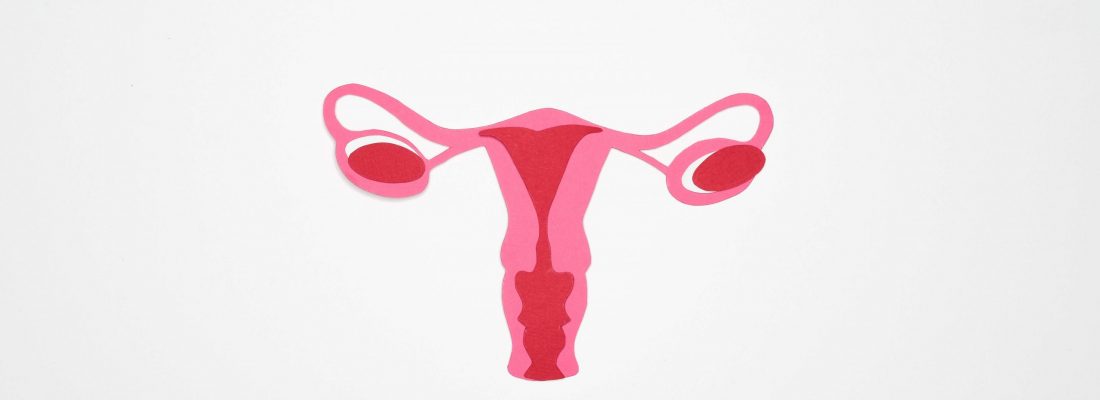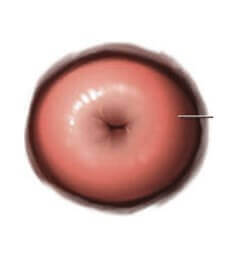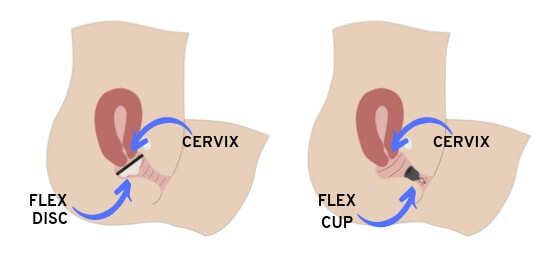
Getting down with your cervix... We know You're curious!

Catherine Work
Allbodies Contributor
Have period cramps? You probs think about your uterus. Got your period? Mind’s on your vag. But what about that part in-between? The magical gateway that can lengthen and shorten, soften and harden, open and close… that can produce fluids to help you fight infection, help you get pregnant, have wetter sex, and when you’re pregnant, protect your baby. The cervix! It does so much! Yet, how familiar are you with yours?
In partnership with FLEX
BACK IT UP. WHAT IS THE CERVIX?
The cervix is the passage at the lower part of the uterus which acts as a portal between the vagina and the rest of the uterus.
The cervix is around 1 inch long and if you were to see it from the perspective of a practitioner giving a pelvic exam, it would look like this:

See that little hole? That’s called the external os. So many things come in and out of that little hole… blood, sperm, IUDs. If you have a vaginal birth, this is the hole through which your baby makes it’s grand entrance… Sex toys, penises, and fingers can all grace its presence, and menstrual cups and discs (like FLEX!) sit underneath it! (But these things don’t go inside)
How does the cervix do so much? It’s made of specialized cells and tissues different than the rest of the uterus (1).
How Do You find Your Cervix?
If you’ve ever put a FLEX disc in before, or even a menstrual cup, you’ve likely felt it!

What Does the Cervix Feel Like?
For the most part, the cervix is smooth and fleshy and about an inch in diameter- like a quarter (6).
But get this, your cervix actually changes all. the. time. It can feel deeper inside you or lower in your vagina (aka easier to reach), soft or more firm, slightly open or more shut (9). And, these changes can tell you about where you are in your menstrual cycle. COOL!
How Does The Cervix Change Throughout the Menstrual Cycle?
There are two things that change throughout your cycle: the cervix itself and the fluids it produces. See that stuff in your undies? That’s called cervical fluid. And that fluid changes consistency throughout your cycle to help you, or prevent you from conceiving.
Here's how it works
During the Bleeding phase
aka your period
Fluid: You’ll mostly see blood, duh! You are still producing cervical fluid, but it may be harder to see mixed in with the blood (13). If you use a FLEX disc or cup, you may be able to see the fluids better when you go to clean it out.
Cervix: Lower in the vagina (so it’s easier for you to shed. that. lining), more firm and slightly angled (better aim out the vag!) The os will be slightly open so you can bleed it out.
During the Follicular phase
These are the days leading up to ovulation.
Fluid: Starts off pretty scant, dry and sticky. As you head towards ovulation it may become more plentiful, even creamy in consistency. As you inch closer and closer to ovulating, you may see the consistency become more watery, cloudy and/or stretchy. The change you’ll notice is that you go from moist and sticky, to wet.
Cervix: The cervix is lower in the vagina. It is more firm, and the os is closed to visitors.
During Ovulation
This is when the follicle releases an egg
Fluid: Stretchy and an egg-like consistency. This type of fluid ups sperms chance of survival in the acidity of the vagina and carries them through most successfully to meet the egg.
Cervix: The cervix is soft, higher up in the vagina (so the sperm have less traveling time to meet the egg #genius) and the os is open wide (15).
During the luteal phase
Post ovulation through when you start bleeding again
Fluid: Your cervical fluid will lose its egg-white elastic or wetter consistency and start to become sticky again. #shopclosed
Cervix: Low and firm and slightly angled. Os is closed again.

A Couple of important Notes!
Because hormonal birth control is aiming to prevent conception, if you are on it, the aforementioned may not necessarily be accurate for you. But it’s still a good idea to get to chum it up with your cervix understand its changes!
Also, If you’ve given birth vaginally before, your os may remain slightly open, always!
How Does the Cervix Move So Much?
It’s all about those hormones, baby! The rise and fall of estrogen causes the ligaments that connect the uterus and pelvis to constrict and this pulls or releases the uterus (14). (Remember the cervix is at the bottom part of the uterus, so it goes up and down with it.)
Estrogen levels peak right before ovulation (these hormones are what’s pulling the cervix up) then the hormones levels (and therefore cervix) drop right after the egg is released (14). #fun!
And, get this, these changes can tell you about where you are in your menstrual cycle. WOW WOW WOW
How Do Cervical Changes Affect My Sex Life?
While some people love the sensation of a penetrative part or object brushing against the cervix and may even experience cervical orgasms, for others, the sensation is uncomfortable. Because the cervix is changing its length and position throughout your cycle, you may find that certain positions are more or less comfortable and pleasurable for you at different times.
This doesn’t mean that position is forever doomed for you! Try again in a few days to see if it was your cervix causing the discomfort- it may have shifted!
Tip: Keep track of when you feel discomfort. You may start to see a cyclical pattern which can clue you in to your cervical changes!
Fun Fact: If you have an IUD, cervical change is also why a partner may feel your IUD strings some times, but not others.
Another Fun Fact: You can keep a FLEX disc in right under the cervix during penetration!
Please note: If you are continuously experiencing pain or bleeding during penetration, it’s never a bad idea to get your cervix looked at!
I'm Paying Attention to My Cervix Now! What are some Indicators that Something May Be Up Down There?
- Bleeding throughout your cycle: While bleeding during ovulation or spotting before your period can be totally normal, if you experience excess bleeding outside of your bleeding phase, and you know you aren’t ovulating, it’s a good idea to check in
- Smelly or weird stuff coming out: If you see yellow or white pus, yeast, or grey cervical fluid it’s never a bad idea to ensure you don’t have an infection
- You have an IUD and you can’t feel your strings, or they feel out of place
- Your cervix feels puffy or inflamed
- You often bleed after penetration
Keepin' Your Cervix Happy and Healthy
- Get regular pap smears
- Use protection during sex
- Limit smoking tobacco products
- Take care of your immune system!
- Bathe regularly with mild soaps
Cervical Changes and IUDS
Your cervical position can make a difference in your IUD placement or removal experience! Because your cervix is lower in your vagina and slightly more open when you are on your period, it’s the best time to get it done (slightly more open and easier to reach = easier to get it in or out). It also means the chances that you are pregnant are very, very, very low. (12). This being said, most clinics will place and remove the IUD at any point of your cycle, but always check in advance because some may have policies that restrict you.
Your Cervix and Menstrual Cups + Discs
Why are we talking so much about menstrual cups and FLEX discs here? Because they are a cool period tool to help you get cozy with your cervix. And, neither disrupt your cervix or dries out your vag so there’s less added chance of infection.
If you don’t already have a ritual where you check on your cervix, this a good opportunity to get that convo started!
Medically reviewed by: Danielle LeBlanc, RN
All content found on this Website, including: text, images, audio, or other formats, was created for informational purposes only. The Content is not intended to be a substitute for professional medical advice, diagnosis, or treatment. Always seek the advice of your physician or other qualified health provider with any questions you may have regarding a medical condition
1. https://www.ourbodiesourselves.org/book-excerpts/health-article/the-cervix-close-up/
2. https://www.ourbodiesourselves.org/book-excerpts/health-article/benign-cervical-conditions/
3. https://www.ourbodiesourselves.org/book-excerpts/health-article/cervical-polyps/
4. https://www.ourbodiesourselves.org/book-excerpts/health-article/preventing-cervical-cancer-hpv-vaccines-faq/
5. https://www.ourbodiesourselves.org/book-excerpts/health-article/cervical-dysplasia-and-cervical-cancer/
6. https://helloclue.com/articles/cycle-a-z/how-to-find-feel-your-cervix
7. https://www.ncbi.nlm.nih.gov/pmc/articles/PMC4367055/
8. See pictures of your cervix here: https://beautifulcervix.com/cervix-photo-galleries/
9. https://beautifulcervix.com/cervical-changes-throughout-the-cycle/
10. https://www.msdmanuals.com/home/women-s-health-issues/noncancerous-gynecologic-abnormalities/cervical-stenosis
11. https://www.verywellhealth.com/what-you-need-to-know-about-your-cervix-513843
12. https://www.ncbi.nlm.nih.gov/pubmed/679301
13. https://www.plannedparenthood.org/learn/birth-control/fertility-awareness/whats-cervical-mucus-method-fams
14. https://beautifulcervix.com/cervical-changes-throughout-the-cycle/
15. https://flo.health/menstrual-cycle/health/ovulation/how-to-check-cervix-for-ovulation
16. https://myhealth.alberta.ca/Health/pages/conditions.aspx?hwid=stt11635&
17. https://www.ncbi.nlm.nih.gov/pmc/articles/PMC5070623/
18. Hendrickson-Jack, Lisa. The Fifth Vital Sign. Fertility Friday Publishing, Inc. 2019